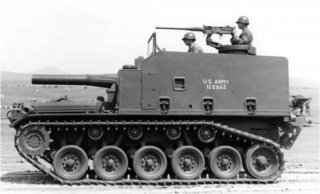History Explains What Turkey's Mobile Artillery Plan To Do In Syria
The original M-52 was a squat-looking vehicle weighing just over 27 tons. Its primary armament was a single M-49 howitzer.
Here's What You Need To Remember: The T-155 has many of the same features and components as the South Korean Army’s K-9. Turkish forces have employed these weapons into combat against Kurdish insurgents and as part of cross-border operations into Syria.
In February 2017, Turkish troops brought out tanks, armored personnel carriers, self-propelled artillery and more for an annual winter war game called Kış Tatbikatı. Among the various weapons on display on the snowy training grounds were mobile howitzers that Turkey has had in service for over 50 years.
Between 1963 and 1966, Turkey received more than 350 M-52 guns from the United States, according to data from the Stockholm International Peace Research Institute. After World War II, the U.S. Army developed the tracked 105-millimeter weapons as part of a whole family of new vehicles to prepare for a major confrontation with the Soviet Union.
“In this era of a possible two-sided atomic war, where movement and dispersion are so vitally important, both in the offense and defense, vehicle mobility is more a matter of life or death than ever before,” a 1957 Army training aid declared, speaking about the M-52 and its cousins.
Five decades later, a significantly upgraded version is still ready for more conventional combat in and around Turkey — at least in theory.
The original M-52 was a squat-looking vehicle weighing just over 27 tons. Its primary armament was a single M-49 howitzer.
For limited defense against troops on the ground and low-flying aircraft, the vehicle had a .50 caliber machine gun on top. The five-man crew would also have their individual weapons.
The mobile howitzer had a maximum speed of only 35 miles per hour on flat, paved roads. The main advantage over a truck towing a similar gun was its off-road capabilities.
While the vehicle had armor on all sides and on top, it offered a defense against rifle bullets and shrapnel at best. And in exchange for this protection, the crew had to work in a relatively small space.
“Although the new family of weapons has shown a great improvement over the older type of self-propelled weapons, they still have certain inherent drawbacks,” the 1957 pamphlet noted. “These are primarily weight, size, high fuel consumption and lack of adequate operating space.”
Perhaps the armored howitzer’s best feature was its commonality with the M-41 light tank and the Army’s other tracked artillery pieces. The M-42 mobile anti-aircraft gun and M-44, M-53 and M-55 self-propelled guns shared approximately 85 percent of their parts with M-52. This made it easier for units to keep spare parts in stock and for mechanics to keep the the vehicles running.
In 1962, the Army began replacing the M-52s with the M-108, a new 105-millimter mobile weapon that had components in common with the M-113 armored personnel carrier. But the older vehicles remained in service with American allies such as Belgium, Greece, Turkey and Japan.
Fast forward to the 1990s and the Turkish M-52 fleet was decidedly obsolete. But rather than scrap them, Turkey choose to substantially modify them.
After testing various upgrades, the Turkish Army choose a German-made package. As part of the deal, Rhinemetall supplied a reworked turret with the same 155-millimeter gun found on Germany’s M-109A3G self-propelled guns.
With rocket-assisted ammunition, these cannons could hit targets more than 18 miles away. On top of the new armament, both sets of vehicles got new diesel engines and other gear.
Rhinemetall offered a similar set of improvements for Turkey’s aging M-44 155-millimeter self-propelled howitzers. Between 1995 and 1998, Turkey purchased enough kits to convert its entire inventory of M-52s.
The resulting M-52Ts were nearly 10 miles an hour faster, significantly more fuel efficient and decidedly more powerful than the original versions. The Turkish Army eventually installed a computerized fire control system, as well.
However, the modifications didn’t fundamentally change the vehicle’s relatively small dimensions. If anything, the larger weapon would have taken up more space inside the similarly shaped turret.
Despite the obviously cold temperatures, the picture of the M-52Ts at Kış Tatbikatı show crews driving with the doors and hatches open. Through one of these openings, you can easily see the cramped interior.
Video footage from the practice sessions, seen above, shows gun teams appearing to fire their weapons from outside the vehicle. Despite the clear improvements, the vehicles are showing their age.
In 2001, the Turkish Army began building T-155 Firtina 155-millimeter mobile howitzers. Turkey’s military developed the vehicle with help from South Korean conglomerate Samsung Techwin.
As a result, the T-155 has many of the same features and components as the South Korean Army’s K-9. Turkish forces have employed these weapons into combat against Kurdish insurgents and as part of cross-border operations into Syria.
Since then, the M-52Ts have mainly made appearances during exercises. While they might be fine for mock battles, Turkey appears to keep the vehicles in reserve. The updated M-44Ts are gone completely.
But if a larger conflict ever broke out in neighboring Syria or elsewhere in the region, the Turkish Army probably wouldn’t complain about having another 350 self-propelled guns on hand.
Image: Wikipedia.

